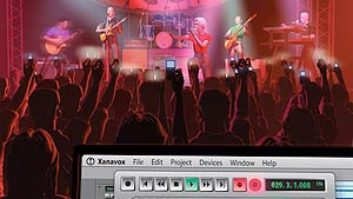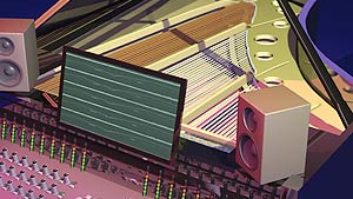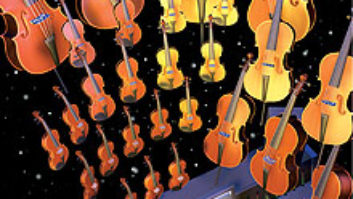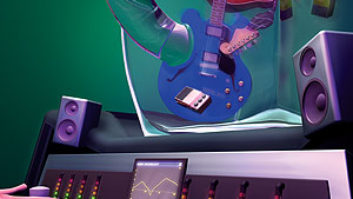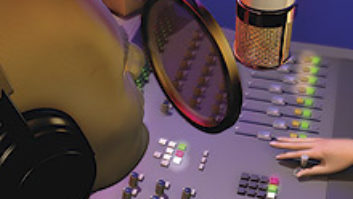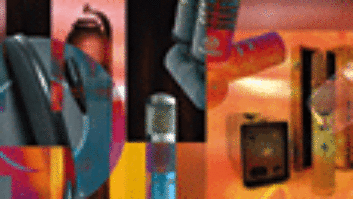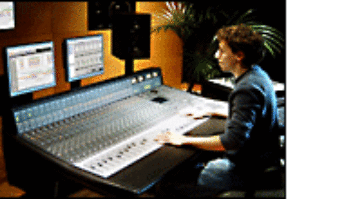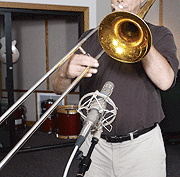

English conductor and obvious curmudgeon Sir Thomas Beecham said, “Brass bands are all very well in their place — outdoors and several miles away.” But don’t tell that to any pop music or jazz lover since the dawn of recording. For nearly 100 years, these instruments have helped drive popular music to new heights of popularity. The horns of Bix Beiderbecke; Louis Armstrong; Glenn Miller; Sly and the Family Stone; Chuck Mangione; Chicago; Blood, Sweat and Tears; Earth, Wind and Fire; and Kenny G still tickle the listener’s musical palate — even years after their heyday.
The engineer’s job is to capture this shouting ensemble and bring it to the listener. This studio role is especially challenging as horns do not fare well when forced into a smaller environment. Because of their sheer power, horns sound best when they can breathe — when you can hear them interact in an ambient space. In a roundabout way, Beecham had it right: There’s something that adds to the excitement of a horn section when you hear it from a distance, when it’s interacting with the room. For this reason, microphone and player setup become very important. This installment of our “Recording the Band” series explores what it takes to record the perfect horn track.
TRUMPETS AND BONES
The trumpet is by far the loudest of the horns, with a large dynamic range that can reach from soft melodies up to stabs and shouts that curl your hair. The instrument emanates sound from the bell and is best miked from a distance for a number of reasons. At its peak, a trumpet can easily overload even the most robust mic, but more importantly, the sound of the horn captured directly at the bell is too strident; trumpet sounds best as a blend of direct and reflected sound.
Mike a trombone approximately two to five feet from the bell of the instrument.
photo: Chris Bailey
When tracking a solo trumpet, you have the luxury of recording it at varying distances by using room mics. You could, for instance, use a single cardioid condenser pulled back about four to six feet from the bell, with a pair of stereo room mics placed further in the room. Depending on the space’s size, try varying the distance of the room mics to capture more ambience. Good mics for this application include large-diaphragms such as a Neumann U47 FET or U87 or a smaller-capsule mic such as a DPA 4011 or Neumann KM54. These mics can all take high levels and they sound great. A pair of omni or cardioid mics in the room — such as a Neumann KM 83i, AKG 451E or SE Electronics SE-3 — would work well to pick up ambience. Room mic setup can vary from ORTF to spaced pairs; spaced pairs provide a “larger” sound because of the spread between the mics. Ribbon mics such as the AEA R88, R92 or Royer 121 or 122 also work very well with trumpets, rounding out the transient edges and exhibiting an overall smooth sound.
If you are recording trumpets in a section with other horns, then the mic can be placed four to five feet back from the trumpets. Using one mic for two trumpets lets the players achieve their own natural balance and will be more economical, track-wise, especially if you set the section up correctly in the room as discussed below. Good mics for capturing the horn’s timbre would be any of the mics mentioned above or even a ribbon mic. Even when the mic is pulled back a few feet from the horn or has a figure-8 pattern such as the ribbons, the instrument’s sheer dynamic power will overcome any leakage problems from the other players in the section.
Trombones can rock the house with level but don’t have as much power as a trumpet. Trumpets put out more sheer SPL and have a more piercing tone and a higher range. Techniques for recording solo trombone are similar to that for a trumpet. Pull the mic about two to five feet away from the bell, relying on your ear to determine whether you have as much of the room as you need. When recording trombones in a section, keep the mic about a foot from the bell of the instrument. This technique helps keep it well-isolated for the mix. Unlike with trumpet, if there is more than one trombone player, then it’s best that each has its own mic. This setup keeps the “battle of the slides” to a minimum and the possibility of a collision low.
SAX AND FRENCH HORN
Saxophone is capable of subtle nuance but doesn’t have the dynamic range of a trumpet or trombone, so putting mics closer to the instrument is ideal for section work. Like all horns, for solo work, you can experiment with moving the mic back to get more room, but generally, close-miking is the ticket to catch the sax’s subtleties of dynamic range.
When recording alto or tenor saxophone with a single mic, aim it toward the center of the instrument.
photo: Chris Bailey
Techniques for recording saxophones vary across the range of the instrument family, with the common theme being that the sound of the horn does not emanate from the bell but from the keys and bell in combination. For this reason, when recording alto and tenor, place the mic a foot or so from the horn; placing it up toward the center of the horn works best when using a single mic. This technique can also be applied to solo or section work. For solo sax, try placing the mic further back into the room, positioned about ear-high and pointing toward the horn for more room interaction. A good multi-mic technique is placing one mic pointed directly at the bell and another up closer to the keys eight to 12 inches away. If the player has a tendency to move around a lot, then give the instrument more room.
Baritone sax is a bit different because its bell curves up higher on the horn than an alto or tenor, so you can’t really get to the keys with a microphone. For bari, a single condenser mic pointed at the bell and placed about two feet away works well, as does pointing a second mic up close to the bottom of the horn to pick up the low-end sound that naturally emanates from there. A ribbon can also work well on a solo bari sax because the mic naturally rounds out the transient edge of the horn on short notes while providing a nice warm and extended bottom end, especially in close proximity. However, a ribbon does not work well on saxophones in a section with other mixed horns due to leakage. In this situation, a cardioid condenser gives you the necessary dynamic range and the ability to cancel off-axis signals.
The soprano sax with its straight bell changes your mic placement a bit. Its bell points downward and the keys are oriented toward the listener. Like the other saxes, the soprano is capable of very quiet passages, so close-miking works well. And, like its brothers, the instrument emanates sound from the keys and bell, so a single mic also works well when placed in the lower third or the horn, pointing at the keys about a foot back. You will certainly get key noise when recording soprano this way, but that’s the nature of the beast. Here, a condenser mic captures the instrument’s upper range nicely. Two mics can be used: one pointing at the bell about six inches away and the other at the keys in front of the horn about eight to 12 inches from the instrument. This gives you the ability to mix the more strident sound at the bell and the warmer timbre emanating from the front of the horn to taste after the recording.
Kenny G’s signature soprano sax sound is achieved by placing a single mic pointed directly at the bell of the horn in close proximity. In this case, the artist prefers to listen through speakers rather than headphones, so it is critical that the mic be directional. He adjusts the optimum speaker level in the room so he can hear the track as he plays, yet doesn’t get a lot of the track leaking into the mic. When recording, the mic is set directly between and in front of the speakers in the control room, just behind the listening position. The track playback level is then set to optimum and marked on the control room’s volume knob, so if the setup is struck and then returned to days later, the level is the same. The best way to check the playback level is to record the mix played back through the speakers. Of course, feedback and leakage are an issue, so it’s best to keep it as low as possible. On Kenny G’s Breathless CD, a Neumann TLM 170 and EF Control mic preamp were patched directly (no EQ or compression) to a Sony 3348 HR digital multitrack tape machine.
The French horn is in its own category, sounding best when miked at a distance rather than up-close to capture a higher ratio of reflected energy reacting with the room. In fact, to truly capture a French horn’s timbre, mike the horn where you can capture more reflected energy than direct energy. For this reason, the players should be placed with their backs to a wall or some other boundary such as a large gobo. Place the mic four to six feet in front of the player, five feet above the floor, facing the reflective wall or surface. If the sound isn’t developing enough in the room at this distance, try moving the mics even further back. Also, because the horn projects in all directions, it would be obtrusive in a section and should be recorded as an overdub for maximum flexibility when mixing.
SETTING UP THE PLAYERS
When setting up a horn section in the room, the goal is to have the players be able to communicate visually, hear each other and keep the louder horns from smothering quieter horns in their individual mic feeds. Because the studio is a controlled environment and it’s not necessary to orient the players to an audience perspective, you can position everyone for optimal comfort, communication and isolation.
One setup for recording a four-horn section comprising two trumpets, one sax and one trombone. Arrange the players in a wide “u” shape facing inward. Capture both trumpets with a single mic, placed four to five feet away. Have the trombone and sax face each other, with their mics placed no more than a foot from the instrument bells.
Jerry Hey, an L.A.-based trumpeter with a discography that reads like a who’s who in recording (see sidebar on page 38) has some very specific ideas on horn section setup, depending on the number of players involved. For a small section (two trumpets, one sax, one trombone), he sets players side-by-side in a line facing their mics. For a larger section such as a big band (four trumpets, four trombones and five saxophones), he uses a non-traditional setup: Rather than set up the band as it would be oriented onstage — saxes in front, trombones behind them and trumpets at the back — he sets the brass up in a wide “v” with the musicians playing into the open room, giving the horns room to breathe. The “v” is set up with the trumpets and trombones on either side of the “v” and the saxes behind the trombones. This keeps the brass from leaking into the saxophones. As a side note, leakage is not bad when recording a section; rather, it can add a touch of reality and ambience to the track. The thing to watch out for is making the leakage unmanageable in the individual tracks. For instance, having too much trumpet in the trombone and sax tracks will make your mix a nightmare.
For a smaller section of four players — two trumpets, one trombone and one sax — setting the musicians in a “u” shape playing into the center works well. The trumpets are positioned at the bottom of the “u,” with the trombone and sax facing each other at the sides. (See the figure on page 40.) This setup lets the trumpets adjust their mixes to their mics and keeps the trombone and sax off-axis from each other. Because the trumpet is the loudest of the three instruments, it’s expected that you’ll get leakage into the other mics. But with the sax and trombone each having their own mic, you can make them louder in the mix by bringing up their respective tracks.
Once you set up the players and get their instruments miked up properly, you can experiment with some stereo pairs to bring the room more into play. A stereo pair placed across a section (such as a Royer SF-24 stereo ribbon) can give you an extra bit of ambience to play with during the mix, bringing the section more into focus with the rest of the track. If the horn section is larger, then individual pairs can be placed across each section, providing you with a lot to play with during the mix. Depending on how you set up the players, the stereo pair can be pulled back further in the room to add ambience.
Large-diaphragm microphones work well on trumpet.
photo: Chris Bailey
If need be, a touch of compression can help tame down a section that jumps too far out of the track and is uneven, but wait until the mix, as adding compression and EQ during tracking can paint you into a corner that could be difficult to get out of later.
IN THE MIX
Reverb and delay work very well with horns. A simple delay can make a solo horn sound haunting, such as the solo trumpet from Jerry Goldsmith’s Patton score. A simple two or three notes with a medium delay with many repetitions acted as a theme for Patton’s past life experiences and is a signature part of the score.
Bruce Swedien’s use of a reverb with a long decay on his mix of Michael Jackson’s “Don’t Stop Til You Get Enough” rocks the track. On the flip side, no one can argue that the “dry as a bone” horns on an Al Green track certainly stands the test of time. The rule is, there are no rules. Let the music dictate the treatment.
When mixing the horns as a section, if they are recorded as mentioned above, you should not have problems getting each horn to be heard in the mix. One nightmare would be if you had so much brass leakage on sax tracks that you couldn’t get enough sax in the mix. This is why getting it right at the tracking session is so important, as fixing it in the mix is not an option.
Trumpets will naturally dominate the horn section mix with the trombones, saxes and even French horns playing a supportive harmonic role. There will be leakage from the other section members in the trumpet mics, and if “more me” is needed, you can get it from the close-miked trombones and saxes or overdubbed French horns. Panning is to taste, but if you have multiple passes, straddle the center image a bit to keep the horns out of the vocal’s way. Solo instruments will most likely be panned in the center.
When dealing with EQ and compression, you’ll often deal with the horn section as a single unit. As mentioned above, EQ and compression are best added at the mix stage. Sometimes a bit of high-end boost will dig the section out of the overall mix when the background is thick with guitars, keyboard pads and other space-gobbling instruments. A bit of mild compression can smooth out the section, sitting it down nicely in the mix.
Whether you’re recording solo horn or a big band, capturing the excitement of the instrument when it’s played to the top of its game is an experience an engineer will never forget. Horns are definitely some of the best icing on the cake that music has to offer.
Kevin Becka is Mix’s technical editor.
THE STORY BEHIND THE SOUND
Fred Catero and Chicago Transit Authority
Recording expert Fred Catero’s credits range from Big Brother and the Holding Company’s
Cheap Thrills
; Blood, Sweat and Tears’
Child is Father to the Man
; and Herbie Hancock’s
Headhunters
. His career spans back to the heyday of New York’s Columbia Records, where he recorded the subject of this sidebar: Chicago’s 1969 debut,
Chicago Transit Authority
.
“We recorded the album at Columbia’s Studio A, a large room where they did Johnny Mathis, [Barbra] Streisand, Tony Bennett, Mel Tormé and the big bands,” says Catero. “In those days, part of the sound was getting the ambience of the room because it was so good; that’s how I was taught.” Fred Plaut mentored Catero in the early days; Plaut was brought from Germany by Columbia’s Goddard Lieberson to work in the label’s U.S. studios. “[Plaut] was a master sound engineer and was responsible for 90 percent of the Broadway shows that came out of Columbia in that era,” Catero says. “He balanced it and mixed it live, and it was all recorded live to a 2-track or even mono in the early days. It sounded gorgeous. His feeling was that if the room sounded good, use it. So that’s what I tried to do.”
The Chicago album was recorded and mixed during a two-week period to an Ampex 8-track machine. “The entire horn section was recorded as an overdub because the arrangements were fairly complex,” Catero remembers. “If someone made a mistake, we did the whole part over.” Catero set the whole section in a line in the large room and used either Neumann or AKG condensers to capture the sound. Catero is very specific about his horn recording techniques: “If you mike close, you don’t get the horn, you just get the bell of the horn. In most horns, and even clarinet and flute, the entire instrument plays and it’s not meant to be heard an inch away from the horn.” He has always taken the approach that a mic is like the human ear: It is meant to “hear things” from a distance rather than at close quarters. As such, he records the players or the section from three or four feet away.
The console used for CTA was a 16-input, Columbia-designed board. For reverb, Catero used popular plates from companies such as EMT, but he also recorded in Columbia’s seven-story echo chamber fashioned from a stone fireproof stairwell that was used for emergency evacuations. “They put a speaker on the seventh floor and on each floor was a microphone. You could mix all these great decays together from the mics,” he says. “The huge explosion you hear in Simon and Garfunkel’s “Bridge Over Troubled Water” is that chamber.”
— Kevin Becka
CASE STUDY
L.A. Horn Man Jerry Hey on Getting the Perfect Sound
Los Angeles — based trumpeter, arranger and producer Jerry Hey has been at the forefront of horn recording for more than 30 years, with an extensive discography including projects for Quincy Jones, Michael Jackson and Dolly Parton. Most of the work Hey does involves a four-horn section comprising himself and Gary Grant on trumpet, Bill Reichenbach on trombone and Dan Higgins on sax.
L.A. horn man Jerry Hey
As far as mic choices for brass, Hey prefers to bring his own mics to the session. His all-purpose favorites for trumpets and trombones are the Royer 121 and 122. (“John Jennings from Royer brought some down to the session and I was sold,” he says.) However, when the session calls for a brighter tone, he goes with the Neumann KM54. “If the horns are battling it out on the track with guitars, live drums and real bass and you need a little more edge to it, I go with the KM54,” he says. Hey recently completed recording horns for a song on the latest Earth, Wind and Fire CD, which was produced and written by David Foster. “[Engineer] Humberto Gatica requests that I bring my KM54 to the session,” Hey says.
As for sax, Hey has other preferences. “A ribbon doesn’t work as well for a sax because it’s a figure-8,” he says. “With trumpets and trombones in the room and sax not being as loud, the brass tends to get on the backside of that mic, causing leakage problems.” For that reason, he often uses a Neumann U67, KM54 or AKG C12 or 414 on sax.
When miking a horn ensemble, Hey likes to use one mic for every two trumpets and a single mic for each sax and trombone. His approach to processing during tracking is hands-off: “Generally speaking, if you don’t add compression or EQ, you’ve got all the right mics and everyone plays like they’re supposed to play, then it’s going to sound like it’s supposed to sound,” he says.
— Kevin Becka
MORE TIPS FROM THE PROS
Orchestral engineer Keith Johnson engineered on two Grammy-winning albums and has been nominated six times in the Best Engineered Classical Recording category
.
Keith Johnson
On his favorite mics for recording brass: “I use some special and unique mics that are hard to find these days, principally the Sennheiser MKH 404 and 405, which I’ve extensively modified and, on occasion, a pair of AKG CK 26 mics with vacuum tube electronics [Nuvistors] that I place near each other in the hall to produce back slap when we need that triumphant brass sound. I also place Sennheiser MKH 104 or 105 omnidirectional mics along the sides of the hall to record the brass chorus spreads.”
On matching mics with instrument characteristics: “Let’s take the accent sting sound that French horns produce. I’ll take the modified 404s or 405s and place them very high above the horns. The ultra-thin diaphragms and internal slope upward EQ adds harmonics to the main mix. These microphones also double up for percussion accents.
Doug Oberkircher
Doug Oberkircher tracked Sting’s 2000 Grammy-winning performance on the Jason Miles — produced Telarc CD, A Love Affair: Celebrating the Music of Ivan Lins. He has also worked with Gato Barbieri, Spyro Gyra and Blood, Sweat & Tears.
On recording saxophonist Jay Beckenstein: “Placing a U89 on both sides of the soprano and a TLM 103 to pick up the bell works beautifully. Saxophonists tend to move around a lot when they play, and small condenser mics produce lots of fluctuation in level. This method of recording takes care of that problem.”
On recording solo tenor sax: “I’ve had to experiment to get the character of that instrument down as powerfully as I’d like. It’s hard to pick up the full vibration of the tenor. I’ve tried to place the player in front of the glass and put a PZM mic onto the glass, but that produces too much of an ambient sound. It’s mic position more than anything else, and you have to experiment within the environment.”
Over the course of the nine years Antonio Oliart spent at WGBH in Boston, he has been nominated five times for the New England Emmy Awards, winning three of them. Oliart has engineered for the likes of Telarc, Koch International and Philips.
Antonio Oliart
On maintaining a natural acoustic sound in classical recording: “I’d rather mike sections than individual instruments. I like to spot a couple of aerial mics on the brass along with the main stereo set that gives me the blend and distance that I want. I want to keep depth in a classical recording.”
On tried-and-true orchestral miking techniques: “I use B&K — now DPA — 4006s for my main orchestral pair; they yield a very natural string sound without getting brittle or bright. I also blend in a pair of Neumann KM130s. The 130s give me an enhanced bass that the 4006s by themselves don’t capture. I set up the Neumanns in the center and use the 4006s as outriggers.

Our senior editor, Blair Jackson, spoke with five top engineers — Michael Bishop, Al Schmitt, Richard King, Eric Schilling and Lolly Lewis-to glean some specific tips and techniques on recording brass and woodwinds. Read their tipshere.
Click below for clips from Chicago Transit Authority, produced by James William Guercio, engineered by Fred Catero and brass arrangements by James Pankow and Chicago.
